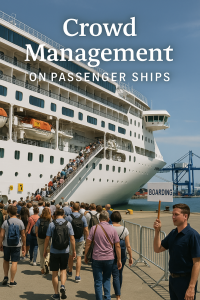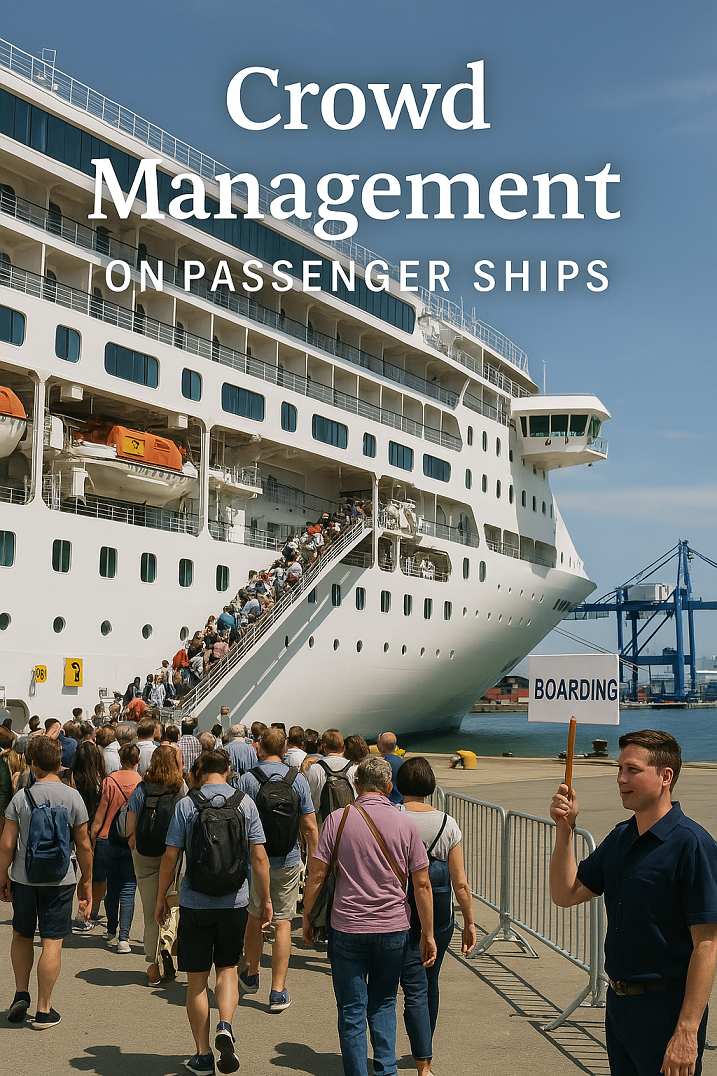
Crowd management on passenger ships is a critical aspect of maritime safety, focusing on the organization, direction, and safeguarding of passengers during emergencies. Given the unique challenges posed by large numbers of people in confined spaces, effective crowd management is essential for ensuring safety and order. This article explores best practices for crowd control, the importance of evacuation drills, and compliance with international maritime safety standards.
The Importance of Crowd Management
Effective crowd management is vital for maintaining order and ensuring passenger safety during emergencies. According to the International Maritime Organization (IMO), passenger ships can carry thousands of individuals, making it imperative to have well-defined procedures for managing large groups. In emergencies—such as fire, flooding, or severe weather—chaotic situations can arise quickly. Without proper crowd management, confusion can lead to injuries or loss of life. The STCW (Standards of Training, Certification and Watchkeeping for Seafarers) Convention mandates that crew members receive training in crowd management as part of their safety training. This training equips them with the skills necessary to handle passengers effectively during emergencies.
Best Practices for Crowd Control
1. Pre-Planning and TrainingEffective crowd management begins with thorough planning and training. Crew members should undergo regular training sessions that cover:
- Emergency Protocols: Understanding the ship’s emergency procedures ensures that crew members can guide passengers effectively during crises.
- Crowd Control Techniques: Training should include strategies for directing passengers to muster stations and lifeboats while maintaining calm and order.
For example, the STCW A-V/2-1 regulation outlines specific competencies required for personnel responsible for crowd management on passenger ships. This includes understanding passenger behavior and effective communication techniques.2. Clear CommunicationCommunication is crucial in managing crowds during emergencies. Crew members must be trained to:
- Use Public Address Systems: Clear announcements can guide passengers to safety efficiently.
- Employ Visual Signals: Signs and signals can help direct passengers in noisy environments where verbal communication may be ineffective.
During a real emergency, such as a fire on board, clear communication can prevent panic and ensure that passengers follow evacuation procedures promptly.3. Designated Assembly AreasEstablishing designated assembly areas is essential for effective crowd management. These areas should be clearly marked and easily accessible. Crew members should ensure that all passengers are aware of these locations during safety briefings at the start of each voyage.For instance, on a cruise ship, assembly areas might be located on open decks or designated lounges where passengers can gather safely during an emergency.
Evacuation Drills
Regular evacuation drills are a critical component of crowd management on passenger ships. These drills help familiarize both crew members and passengers with emergency procedures, ensuring that everyone knows what to do in case of an actual emergency.1. Conducting DrillsEvacuation drills should be conducted at least once per voyage and involve all crew members and a representative sample of passengers:
- Realistic Scenarios: Drills should simulate realistic emergency scenarios to prepare everyone for potential challenges.
- Role Assignments: Crew members should have specific roles during drills to ensure efficient execution of evacuation plans.
Data from various maritime safety studies indicate that vessels that conduct regular evacuation drills experience fewer incidents of chaos during real emergencies. For example, the Costa Concordia disaster in 2012 highlighted the importance of effective evacuation procedures; many lives were saved due to prior drill experience among crew members.2. Passenger ParticipationEncouraging passenger participation in drills enhances their preparedness for emergencies:
- Safety Briefings: Conducting briefings before drills informs passengers about what to expect.
- Engagement Activities: Involving passengers in hands-on activities during drills helps reinforce their understanding of safety protocols.
Compliance with International Maritime Safety Standards
Compliance with international maritime safety standards is essential for effective crowd management on passenger ships. The STCW Convention and SOLAS (Safety of Life at Sea) regulations provide guidelines that vessels must follow to ensure passenger safety.1. STCW RegulationsThe STCW Convention outlines specific training requirements for crew members involved in crowd management:
- Mandatory Training: All personnel providing direct service to passengers must complete STCW-compliant crowd management training.
- Competency Assessments: Crew members must demonstrate competency in managing crowds effectively during emergencies.
The training covers various aspects, including communication techniques, behavioral psychology related to crowds, and effective use of emergency equipment.2. SOLAS RequirementsSOLAS sets forth requirements for passenger ship safety measures:
- Lifeboat Capacity: Ships must have sufficient lifeboat capacity for all passengers and crew.
- Emergency Equipment Accessibility: Safety equipment must be easily accessible to both crew members and passengers during emergencies.
These regulations are designed to enhance overall safety onboard passenger vessels by ensuring that adequate measures are in place for effective crowd management.
Case Studies Highlighting Effective Crowd Management
Several incidents underscore the importance of effective crowd management in maritime settings:
- MV Estonia Disaster (1994): The sinking of the ferry MV Estonia resulted in the loss of 852 lives, partly due to inadequate crowd control during evacuation efforts. Investigations revealed that confusion among passengers led to chaos as they attempted to escape. This tragedy highlighted the need for comprehensive training and clear communication protocols among crew members.
- Costa Concordia Incident (2012): The Costa Concordia disaster demonstrated both successes and failures in crowd management. While many crew members effectively guided passengers during evacuation efforts, others failed to communicate critical information promptly. The incident underscored the importance of regular drills and effective communication strategies in managing crowds during emergencies.
- MV Rena Grounding (2011): After the grounding of this container ship off New Zealand’s coast, effective crowd management was evident as crew members organized evacuations efficiently while ensuring passenger safety amid challenging conditions. The successful response was attributed to prior training and well-defined emergency protocols.
Conclusion
Crowd management on passenger ships is a vital aspect of maritime safety that requires careful planning, training, and adherence to international regulations. By implementing best practices such as clear communication, designated assembly areas, regular evacuation drills, and compliance with STCW and SOLAS standards, ship operators can significantly enhance passenger safety during emergencies.The lessons learned from past incidents serve as reminders of the importance of effective crowd management strategies onboard vessels carrying large numbers of people. Investing time and resources into training crew members in these practices not only protects lives but also fosters a culture of safety onboard ships—a commitment essential for all maritime professionals navigating our oceans today.

